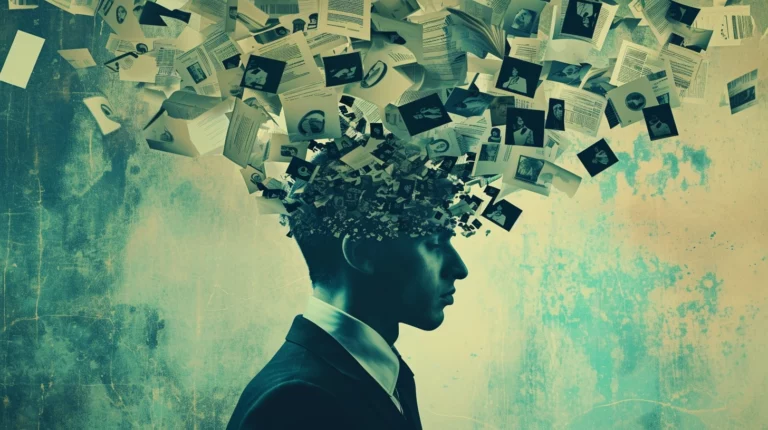Table of Contents
ToggleIntroduction: Mastering your memory with the power of Mnemonics
Imagine struggling to recall the order of operations in math. Suddenly, a catchy acronym like BODMAS (Brackets, of (Exponents), Division, Multiplication, Addition and Subtraction) appears, solidifying the concept in your mind. Mnemonics come in diverse forms, catering to different learning styles.
Mnemonics is a basic system for improving and aiding in memory and memory recall. Think of acronyms, rhymes, and songs! The true magic of mnemonics lies in their versatility. You can tailor them to any subject, transforming historical dates, scientific formulas, or even foreign languages into memorable pieces. Imagine crafting a funny rhyme to remember Shakespearean sonnets or creating a colourful acronym for the periodic table – the possibilities are endless!
Mnemonics techniques
Learning does not always have to be a struggle. Mnemonics offers a toolbox of clever strategies to boost your memory and make learning more enjoyable. These techniques, like mental shortcuts, help you remember information more effectively.
Keyword Mnemonics
When learning any word, try to associate the word with something.
Imagine you are learning Spanish, and “gato” means “cat.” Picture a gate with a fluffy cat perched on top. The association between the “gate” and the “cat” helps you recall the meaning of “gato.”
Another example in the subject of English, remember the difference between “there,” “they’re,” and “their.” Picture a “chair” (“there”), “they are” reading a book (“they’re”), and a person holding their “belongings” (“their”).
Chunking
When trying to learn anything, create chunks of information. Group relevant information together and then use that group to learn that information in a more concise way.
Our brains prefer bite-sized pieces. Instead of memorizing a long phone number like “47895328463,” break it down into manageable chunks like “4789 532 8463.” This makes it easier to remember and recall.
Always remember to Break down your phone number into smaller groups (e.g., 3-3-4) and separate long equations into smaller steps (e.g., multiplication, addition etc).

Musical Mnemonics
Remember the alphabet song? Songs can be powerful tools for memorization. From country names to scientific concepts, you can create or find catchy tunes to help you remember information.
- Multiplication Tables: Sing multiplication tables to a familiar tune.
- States and Capitals: Create a song to remember state names and their capitals.
- Scientific Formulas: Set a scientific formula to music (e.g., the water cycle).
- Foreign Language Phrases: Sing common phrases in a new language.
- Historical Events: Write a song about a historical event.
Letter and Word Mnemonics
Acronyms and acrostics are familiar examples. “NBA” stands for National Basketball Association, and “FLAV” can help you remember four types of dementia: Frontotemporal, Lewy body, Alzheimer’s, and Vascular.
- Acronyms Create an acronym for remembering the Great Lakes (HOMES – Huron, Ontario, Michigan, Erie, Superior).
- Acrostics: Write an acrostic to remember the order of operations in math (PEMDAS – Parentheses, Exponents, Multiplication and Division, Addition and Subtraction).
Rhymes as Mnemonics
Always try to rhyme what you are learning. Bathroom singers rejoice! You will be a master at this.
Nursery rhymes often stick in our minds because of repetition and rhyme. The familiar spelling rule “I before e, except after c” is easier to remember thanks to the rhyme. Another good tip is to link the rhymes to those you used to sing as you were a child.
Making Connections
Always take your information and make connections looking at common elements and other information that are similar.
Linking latest information to something familiar makes it meaningful and easier to remember. This might involve connecting a new person’s name to their personality, appearance some unique features of themselves or anything.
For example, do you want to remember together? You can say To-Get-Her and remember it as an action. Remember, the connection is like a map that should lead you to what you want to remember.

Method of Loci
Also called the memory palace technique, you will need to associate information with something. It can be a location, a pen or even an image. When learning about balance in physics, balance the pen in your hand.
Imagine your house or a familiar walk and mentally place facts or information at specific locations along the way. To recall what you learned, visualize yourself revisiting these locations, triggering each piece of information.
A clever way to proceed is with to-do lists, placing each task on one’s day-to-day list and then using specific landmarks, such as objects like sticky notes to remind and recall that memory.
Peg Method
Similar to making connection, this method will require you to initially memorize the information that you have before you and then during recalling that information, you associate it with other elements.
This method is particularly useful for remembering things in order. First, memorize a list of ten words like “bun,” “shoe,” “tree,” “door,” and so on. Then, connect each latest information you want to remember to one of these “peg words.” For example, you might associate the kingdom classification level with a burger bun.
Mnemonic Linking System (Stories or Images)
A good technique to use when you want to remember a series of events. When learning historical events, use a story to connect them. Think about the story as a movie making it easier to remember the story and the information required.
Create a story or image that connects the pieces of information you need to remember. This works by linking each item to the next, forming a chain of associations.
When studying for a test, try to create a story or use the images in your textbook to remember. If you are learning history, use pictures in your textbook to remember the person’s features entirely.

Experts Opinion
Mnemonics are not just passive memory aids. By actively creating your own, you forge stronger connections with the information. The more personal and creative your mnemonic, the deeper the mental imprint and the easier the recall.
Dave Farrow, our in-house expert and a world champion, and record holder in memory calls it the ‘Peg system.’ He says that the best thing you can do is to connect one memory to another in any way imaginable.
Dave Farrow is well renowned, his greatest feats include the ability to memorize fifty-nine decks of cards, which is 3068 cards in one sitting and being able to recall said information at a moment’s notice.
The Dave Farrow Method goes beyond typical mnemonic techniques. It is a multi-sensory system that incorporates visualization, spatial awareness, and storytelling into the memorization process. Farrow encourages users to create their personalized memory palaces, imaginary locations where they can “place” the information they want to remember. This approach uses the brain’s natural ability to remember spatial relationships and forge connections between information and vivid mental images.
The effectiveness of the Dave Farrow Method lies in its adaptability and versatility. It can be applied to various subjects, from historical dates and scientific formulas to foreign languages and literary works. This empowers individuals of all ages and learning styles to actively engage with the information they are trying to remember, fostering deeper understanding, and improving retention.

Advantages of learning Mnemonics techniques
Learning does not have to be a solitary struggle through mountains of information. Mnemonics, those clever memory techniques that utilize patterns, associations, and vivid imagery, offer a powerful toolbox to unlock the secrets of effective learning. From enhanced retention to fostering a love for learning, the benefits of mnemonics are numerous and far-reaching.
Enhanced Retention
Our brains are wired for patterns and connections. Mnemonics exploit this natural tendency by transforming information into memorable formats, like acronyms) or acrostics (“Every Good Boy Deserves Fudge” for remembering the lines on the musical staff). These techniques help us encode information in a way that sticks, making it readily available for recall when needed.
Improved Comprehension
Mnemonics go beyond simply aiding memorization; they pave the way for a deeper understanding of the subject matter. By creating meaningful connections between latest information and existing knowledge, students can grasp concepts more effectively. Imagine associating the phases of mitosis (PMAT – Prophase, Metaphase, Anaphase, Telophase) with a story about a cell dividing and its parts moving around. This association not only helps you remember the order of the phases but also provides a visual representation of the process, aiding in comprehension.

Time is a precious commodity, especially for students. Mnemonics act as an efficient learning tool, allowing students to absorb information at a quicker pace. Instead of spending hours re-reading dry textbooks, students can leverage mnemonics to condense and encode information effectively. This saves precious study time, allowing them to dedicate more energy to critical thinking, problem-solving, and applying their knowledge to real-world situations.
Engaging and Fun
Learning does not have to be dull! Mnemonics inject a dose of creativity, imagination, and even fun into the learning process. By transforming dry facts into catchy rhymes, like “Thirty days hath September…” or vivid mental images, like associating the planets with the mnemonic “My Very Educated Mother Just Served Us Nachos,” students can find learning more enjoyable and engaging. This increased engagement fuels motivation and helps develop a positive attitude towards learning, making the journey of knowledge more fulfilling.
Transferable Skills
The benefits of mnemonics extend far beyond the classroom walls. The cognitive skills honed while using mnemonics, such as organizing information, creating connections, and recalling details, are valuable assets in various domains of life. These transferable skills can be applied to future academic pursuits, professional endeavours, and even everyday tasks like following directions or remembering grocery lists.

Beyond the Techniques
Remember that mnemonics are tools, not one-size-fits-all solutions. Experiment and find what works best for you. Combine these techniques and do not be afraid to get creative! Remember, the more unique and engaging your mnemonics are, the more likely you are to remember the information.
Another thing that you must remember is practice makes perfect!
Mnemonics can be used for various subjects, making learning more interactive and engaging.
These techniques can be helpful for people of all ages, including those with mild cognitive impairment. While mnemonics are powerful, they should not replace other learning strategies like critical thinking and analysis.
By understanding and utilizing mnemonic techniques, you can unlock a world of easier and more enjoyable learning! So, unleash your creativity, personalize your approach, and watch your memory soar!
Conclusion
Mnemonics offer a playful and effective way to boost your memory and enhance learning. By employing various techniques like keyword connections, chunking information, and creating musical associations, you can transform tedious memorization into an engaging and even enjoyable experience. Remember, the key lies in experimentation and personalization. Embrace your creativity, combine different techniques, and unlock the power of mnemonics to conquer any learning challenge you face on your journey to knowledge.
FAQs
- What are mnemonics?
Mnemonics are memory aids or techniques that help individuals remember information more effectively by associating it with easily recallable patterns, such as acronyms, rhymes, or visual images.
- How do mnemonics work?
Mnemonics work by leveraging the brain’s natural ability to remember patterns and associations. By connecting new information with existing knowledge or creating vivid mental images, mnemonics make it easier to encode, store, and retrieve information when needed.
- What types of mnemonics are there?
Mnemonics come in various forms, including acronyms (e.g., PEMDAS), acrostics (e.g., ROYGBIV), rhymes (e.g., “i before e, except after c”), visual imagery, association techniques (e.g., method of loci), and musical associations.
- What are the benefits of using mnemonics?
Mnemonics enhance retention, improve comprehension, reduce study time, make learning more engaging and fun, and develop transferable cognitive skills. They can be particularly helpful for students, professionals, and individuals of all ages seeking to enhance their memory and learning abilities.
- How can I start using mnemonics?
To start using mnemonics, experiment with different techniques to find what works best for you. You can begin by creating simple associations, like visualizing images or creating rhymes, to help you remember specific information. Practice regularly and be creative in developing personalized mnemonic strategies tailored to your learning style and preferences.



